#ninhursag
Explore tagged Tumblr posts
Text

Mesopotamian gods designs for an animation I’ve been working on lately (for my university, huh).
Goofy stuff.
#mesopotamian mythology#sumerian mythology#ancient sumeria#Anu#Enlil#Enki#Ninhursag#Istar#Ashur#Nergal#Ereshkigal#Sin#Utu#Gula#Ninlil
454 notes
·
View notes
Quote
Your heart is dusk, moonlight cannot enter you.
Enheduanna, Enheduana: The Complete Poems of the World’s First Author, to Ninhursag
124 notes
·
View notes
Photo

Kesh Temple Hymn
The Kesh Temple Hymn (c. 2600 BCE) is the oldest work of literature in the world, sometimes referenced as the oldest extant religious poem. It is a Sumerian praise song to the goddess Ninhursag and her temple in the city of Kesh, composed in eight sections of "houses" progressing from the temple's foundation to a cautionary welcome.
Continue reading...
146 notes
·
View notes
Text
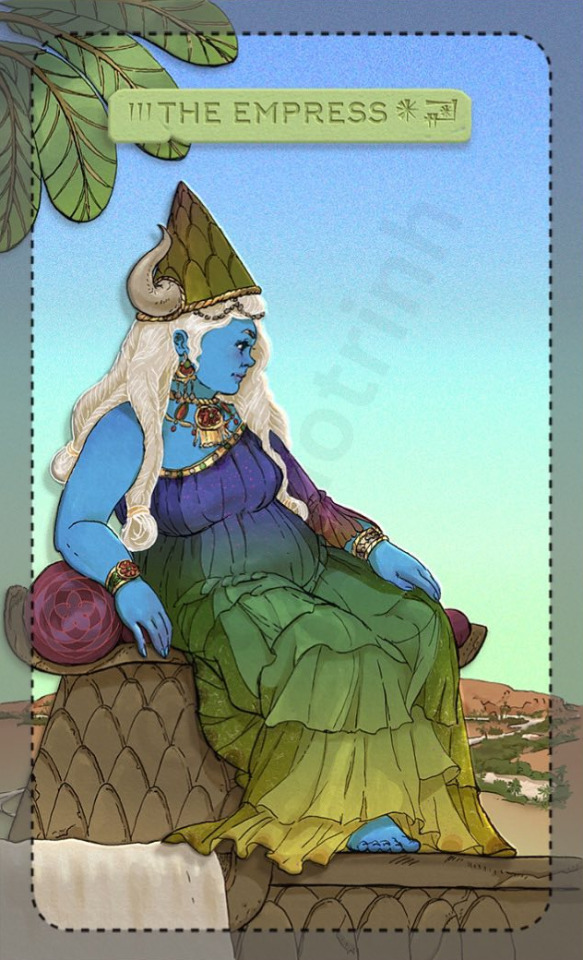
The Empress. Art by Rubi Do Trinh, from the Star of Inanna Tarot.
𒁹𒁹𒁹 The Empress 𒀭𒂼 For this card we decided to depict the Mother Goddess Ki/Ninhursag. Ki is the Earth Mother Goddess ands chief consort of An and Ninhuršag was the Mountain Mother Goddess. According to Samuel Kramer, Ki and Ninhursag are one and the same, and we are inclined to agree. In the Sumerian Creation myth, An and Ki were born of Nammu, the Primordial Mother Goddess. They then came together and Enlil was born. Enlil then separates Ki from An, and they unite. Their union leads to the creation of life on Earth as we know it. Ninhursag has more written about her, but she is also conflated with the Earth and as a Mother Goddess. She has further associations with Mountains and is often depicted with an Omega-like symbol in her hair. Another part of the creation story is found in the myth “Enki and Ninhursag” where they work together to bring abundance, fertility and the possibility of agriculture to the world. She is an essential part of the process of creating humans along with the God Enki. We can see the associations between the archetype of this card and Ki/Ninhursag. Fertility, growth, transformation, creation, pregnancy, childbirth, and nurturing are all aspects that are present in both. However, lesser talked about aspects of this archetype are enforcer of order, & protective yet healing and compassionate. In the Myth “Enki and Ninmah(an epithet)”, when working together to create humans, Enki ends up hurling insults at her creations. In response, she uses her creative powers to punish him, afflicting him with ailments and illnesses only she can heal. She then reveals her compassionate side and ends up healing him. The Cuneiform is: 𒀭 Dingir + 𒂼 ama = Divine Mother
#Rubi Do Trinh#Star of Inanna Tarot#The Empress#Major Arcana#Tarot#Folklore#Sumeria#Inanna#Ki#Ninhursag
12 notes
·
View notes
Photo

Ninhursag
Ninhursag est la déesse-mère sumérienne, l'une des plus anciennes et des plus importantes du panthéon mésopotamien. Elle est connue comme la Mère des Dieux et la Mère des Hommes pour son rôle dans la création des entités divines et mortelles.
Lire la suite...
0 notes
Text
Info: Okay, so it's an au where the Federation either collapsed for some reason (Nero showed up early and destroyed all the major Federation planets?) or never existed.
And Nyota Uhura is a scary BAMF (I don't know what she does. Bounty hunter? Assassin?) with even more terrifying matched set of hunting hounds on her leash. And her hounds, of course, are the very feral but still human (or Vulcan) Kirk and Spock.
They only obey her and whenever she lets them off the lead they absolutely destroy everything in their path. Their main target along with, you know random Klingon Warbirds, stray planets, whatever is there.
Um. Dirty porn is very welcome (and perhaps required?) Nyota's hounds sleep at her feet in bed? Sometimes she has to pull them off each other in public?
Oh, or the time one of her hounds is hurt and she has to find them a doctor (possibly as gun point). And it is McCoy who is all "What? I am a doctor, not a veterinarian!" until he sees them and realizes what she means by hounds and then just goes, holy shit.
And, wow, I feel like a bad person. Someone please write this so I don't have to! (thread)
Fill: 1/1 + AO3
Author: hounds-morrigan (Vaingirlfic) (ninhursag)
Archive link
0 notes
Text
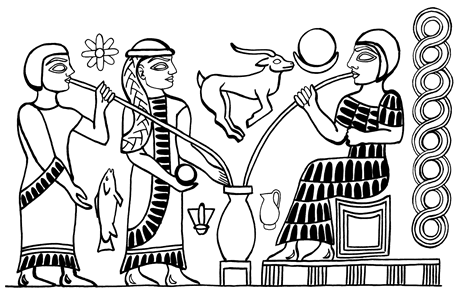
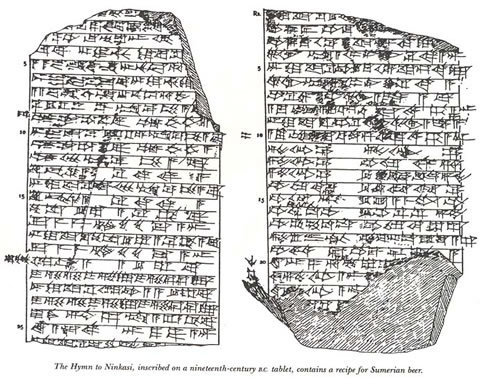

The Hymn of Ninkasi
The Ancient Sumerians loved their beer. In fact they loved their beer so much that thousands of years later ancient recipes and artwork depicting beer making and beer drinking survive to this day. Many of these recipes are being recreated and brewed thousands of years later by crafted breweries today. They drank it for ceremonial and religious reasons, they drank it for nutritional reasons, and they drank it for the same reasons we drink it today. You know ... to get pissed.
The Sumerians were so serious about their beer that they had their own deity devoted to the beverage named Ninkasi. Ninkasi was the goddess of beer and alcohol, who brewed the beverage daily to to “satisfy the desire” and “sate the heart.” One of the earliest known devotions to Ninkasi was a hymn written on clay tablets dating to 1800 BC. Called “The Hymn to Ninkasi” it was more than just a devotional script or prayer, it was a recipe and procedure for brewing, written as a poem so that it would be easy to remember in an age when most people were illiterate. The beer that was produced was a very sweet beverage with around 3.5% alcohol by volume, created by brewing with malt and a twice baked honey bread (bappir) that had the taste and consistency of granola. It would have been very sweet compared to modern beer as the Sumerians lacked hops which gives the bitter flavors of beers today. Traditionally the beer was stored in clay pots and sipped using long drinking straws to filter out left over particulates.
The Hymn of Ninkasi
Borne of the flowing water, Tenderly cared for by the Ninhursag, Borne of the flowing water, Tenderly cared for by the Ninhursag, Having founded your town by the sacred lake, She finished its great walls for you, Ninkasi, having founded your town by the sacred lake, She finished it’s walls for you, Your father is Enki, Lord Nidimmud, Your mother is Ninti, the queen of the sacred lake. Ninkasi, your father is Enki, Lord Nidimmud, Your mother is Ninti, the queen of the sacred lake. You are the one who handles the dough [and] with a big shovel, Mixing in a pit, the bappir with sweet aromatics, Ninkasi, you are the one who handles the dough [and] with a big shovel, Mixing in a pit, the bappir with [date] - honey, You are the one who bakes the bappir in the big oven, Puts in order the piles of hulled grains, Ninkasi, you are the one who bakes the bappir in the big oven, Puts in order the piles of hulled grains, You are the one who waters the malt set on the ground, The noble dogs keep away even the potentates, Ninkasi, you are the one who waters the malt set on the ground, The noble dogs keep away even the potentates, You are the one who soaks the malt in a jar, The waves rise, the waves fall. Ninkasi, you are the one who soaks the malt in a jar, The waves rise, the waves fall. You are the one who spreads the cooked mash on large reed mats, Coolness overcomes, Ninkasi, you are the one who spreads the cooked mash on large reed mats, Coolness overcomes, You are the one who holds with both hands the great sweet wort, Brewing [it] with honey [and] wine (You the sweet wort to the vessel) Ninkasi, (…)(You the sweet wort to the vessel) The filtering vat, which makes a pleasant sound, You place appropriately on a large collector vat. Ninkasi, the filtering vat, which makes a pleasant sound, You place appropriately on a large collector vat. When you pour out the filtered beer of the collector vat, It is [like] the onrush of Tigris and Euphrates. Ninkasi, you are the one who pours out the filtered beer of the collector vat, It is [like] the onrush of Tigris and Euphrates.
320 notes
·
View notes
Text




Anu 𒀭 “Skyfather and Lord of Firmament, or the Great Above.” Talon Abraxas
Anu (also known as An) is an early Mesopotamian sky god who was later viewed as the Father of the Gods and ruler of the heavens, a position which then passed to his son Enlil. He is the son of the couple Anshar and Kishar (heaven and earth, respectively), the second-born of the primordial couple Apsu and Tiamat.
He was originally a Sumerian sky deity known as An (meaning 'sky') first referenced in writing during the Early Dynastic Period (2900-2334 BCE) who was adopted by the Akkadians c. 2375 BCE as Anu ('heaven') the all-powerful. Sargon the Great of Akkad (r. 2334-2279 BCE) mentions Anu and Inanna in his inscriptions as legitimizing his rule or helping him in his conquests as he established the Akkadian Empire and maintained order.
Anu is most often represented in iconography simply by a crown or crown on a throne symbolizing his status as King of the Gods, an honor and responsibility later conferred upon Enlil, Marduk (son of Enki/Ea, the god of wisdom), and Assur of the Assyrians, all of whom were believed to have been elevated by Anu and blessed by him. His consort is Antu (also known as Uras, goddess of the earth), and among their many children are the Annunaki, the gods of the earth and judges of the dead, and Nisaba, the Sumerian goddess of writing and accounts. He is also given as the husband of his sister Ki (earth) by whom his son Enlil is born.
Although Anu is not featured prominently in many myths, he is often mentioned as a background figure. This is because, as veneration of the god progressed, he became more and more remote. Initially a sky god and one of the many younger gods born of Apsu and Tiamat, Anu gradually became the lord of the heavens above the sky and the god who ordered and maintained all aspects of existence.
Along with Enlil and Enki, Anu formed a triad which governed the heavens, earth, and underworld (in one version) or, in another, heaven, the sky, and the earth. He was also listed among the oldest gods of the Seven Divine Powers: Anu, Enki, Enlil, Inanna, Nanna, Ninhursag, and Utu-Shamash.
Even though he is rarely a main character in a myth, when he does appear, he plays an important role, even when that role might seem minor. He is referenced in some of the best-known myths from Mesopotamia including Gilgamesh, Enkidu, and the Netherworld, The Epic of Gilgamesh, the Myth of Adapa, and the Enuma Elish.
53 notes
·
View notes
Note
how is she (Lilith) closed when she exists in Swedish folklore with a different name (Her name is Lucia but it developed into the Saint Lucia tradition to be exact but in northern Swedish folklore she has a darker past where she was adams first wife and her story is very similar to Jewish Lilith).
Edit to add: It's extremely likely that this story about Lucia being the first wife of Adam is more of a modern Internet tale than an old Swedish folktale. I can find no reputable sources to back it up, and people who have familiarity with Saint Lucia/Lussi have informed me that they've heard nothing of this kind, either. That said, my point that similarity between figures does not justify appropriation still stands.
The uniqueness of figures has nothing to do with whether they're open or closed. Your argument is like saying, "well how can this storm god from an African traditional religion be closed when Thor exists?"
The ATR god is closed because the people who whom that tradition belongs said so. If you want to worship a storm god, Thor is right there. Likewise, you are free to work with this folkloric version of Saint Lucy.
Lilith isn't closed because she's supposedly unique. That never had anything to do with it. In fact, "oh but this open figure and that closed figure are basically the same though, that means I'm entitled to the one you're claiming is closed" is the rhetoric of spiritual colonialism, used to justify the misrepresentation and commodification of spiritual figures from marginalized groups, to that group's detriment.
Now, not every Jew agrees that Lilith is closed, because Jews aren't a monolith. But I have seen no shortage of Jews arguing for Lilith as a closed figure, and I find their arguments pretty damn compelling
So, Christians have spent centuries digging into Jewish traditions to find something they could weaponize against Jews; EG, getting into Kabbalah to try and find places they could project Jesus so they could try and convince Jews to convert to Christianity. Something very similar is absolutely happening with the gentile Lilith worshipers. There's a strong tendency toward antisemitic conspiracy theory among them; EG, believing that patriarchy was a Jewish conspiracy that was later expressed through Christianity.
These people often claim that Lilith was this ancient mother goddess who was demonized by the Jews. They try to claim that these old mentions of lilitu are somehow evidence. In reality, ancient cultures in the Near East worshiped a number of mother goddesses (EG, Ninhursag), and none of whom were Lilith.
Many deities did get demonized at some point (EG, Astarte became Ashtoreth, and Baal became Bael), but this had nothing to do with a patriarchal conspiracy; rather it was a generalized demonization of rival gods. And Lilith was not among them, because Lilith was never a goddess.
In fact, I have yet to see a single gentile Lilith worshiper who isn't deep into conspiracy theories and doesn't quote pseudohistory of some kind. Not a single one. So yeah, I will continue taking the side of the Jews who say that Lilith should be closed, because I've seen the bullshit gentiles are pulling with her.
#answered#lilith#antisemitism#cultural appropriation#conspirituality#conspiracy theories#conspiracism#pseudohistory
162 notes
·
View notes
Text
Mesopotamian Pantheon Explained
Hello! My name is Red, I am a devotee of the Mesopotamian Goddess Inanna, and it makes me sad to see that not a lot of people know about her, let alone the rest of her pantheon, so I thought I'd make a post about everyone, or at least, everyone I can. I've made a masterpost about her, and I really enjoyed it, as it gave me an "excuse" to learn about her, and this is the same. In this post I will be naming the gods and their domains and their relations with each other. If prompted, I would love to do a deep dive on every deity in this pantheon I can. Unfortunately, there are over a thousand deities across all Mesopotamian cultures, so this is by no means a complete list or anything similar.
So, first, what is Mesopotamia? Mesopotamia means "land between the rivers", the Tigris and Euphrates Rivers, and it is the term to define the whole region and the various cultures that lived there. This includes Sumer, Akkadia, and Babylon. Despite culture being different, they shared similarities in written language, religion, and attitude towards women. The gods may have had different names at different points, but they were the same deity to all, often referred to interchangeably. This region gave birth to about 50 firsts of man.
But, on to the Gods!
The first thing to know about the Pantheon and how people worked with them, is that mortals believed them to be coworkers with the deities, and that they worked together to maintain order. (*edit: this fact is disputed, the idea that humans were seen mostly as servants seems to be more popular*) Due to differences in cultures, each civilization viewed the deities differently, so Marduk might have been king of the Gods in Babylon, Enlil was king of the Gods in Sumer. The heavenly Gods were referred to as Igigi, and occasionally Anunnaki, though in some sources Anunnaki was the older or "major" Gods, and the Igigi were the lower ranking Gods.
We are going to start with the Seven Divine Powers, the oldest Sumerian deities. (*edit: largely thought to have been manufactured later in history*)
Anu - sky god
Enki - god of wisdom
Enlil - lord of the air, sumerian king of the Gods.
Inanna - goddess of love, fertility, and war, queen of the heavens
Nanna - goddess of the moon
Ninhursag - mother goddess
Utu/Shamash - god of the sun
Other popular deities include
Assur/Ashur - supreme god of the Assyrians
Ereshkigal - goddess of the underworld
Gula - goddess of health and healing
Marduk - babylonian king of the gods
Nabu - god of writing
Nanshe - goddess of social justice
Nergal - god of war
Ninkasi - goddess of beer and brewing
Nisaba - goddess of agriculture, turned to writing and accounts
Dumuzid/Tammuz - god of shepherds
Enkimdu - god of farmers, seen as the personification of the irrigation system
Geshtinanna - goddess of scribal arts and dream interpretation (theorized)
Bau - mother goddess, healing
Ishkur - god of storms and rain
Ištaran - god of divine justice
Nanaya - goddess of love
Nanshe - goddess of divination
Ninazu - associated with the underworld, though his role is disputed
Ninlil - wife of Enlil, thought to be "artificially created" as Enlil's equal
Ninshubur - god(dess) attendant of Inanna (in some sources she is masculine, and others feminine)
Zababa - war god
Alammush - god attendant of Nanna
Sherida - goddess of dawn
Apsu - primeval freshwater
Tiamat - primeval sea
Creation-
The Mesopotamians had many different tellings of the creation of the world, most likely due to the cultural differences. Atra-Hasis, Eridu Genesis, and Enuma Elish are the most common, as we have physical copies of them today. They, among other sources, depict a different family tree, but with key similarities.
Atra-Hasis: Anu, Enlil, and Enki cast lots to determine who rules what. Anu the sky, Enlil the earth, and Enki the sea. Enlil assigned minor gods to farm, but after many years the minor divines refused. Enki suggested to make humans to do the labor. Mother goddess Mami fashions humans out of clay, flesh, and blood of a slain god, and all the gods spit on the clay. After ten months, humans emerged from a specifically made womb. After many years, humans have overpopulated, so Enlil sends famine and drought every 1200 years. Enlil decides to destroy humanity by flood. Enki goes to hero Atra-Hasis and tells him of the plan, instructing him to demolish his house and build a boat. He does, and he brings his family and his animals and seals the door. When the flood comes it stays for seven days and even the gods are afraid. It ends and Enlil is furious with Enki for breaking the vow of silence but eventually the two agree to find other means of controlling the human population.
Eridu Genesis: the beginning of this has been lost to time. The surviving portion starts with Nintur, the goddess who birthed humanity, where she calls for them to he sedentary and civilized. Then more is missing. It resumes with humanity still being nomadic and barbaric. Nintur is stilling planning to provide kingship to the mortals. Then cities emerge, are named, and become distributional economies. Humans begin to annoy the gods, Enlil was unable to sleep, and made the brash decision to destroy humanity with a flood. Enki tells Ziusudra, a human, and tells him to build a boat to save himself and one couple of every animal. Ziusudra does as he is told and the flood comes. Humanity survives, but the rest is lost to time.
Enuma Elish: at the beginning, Apsu and Tiamet existed, co-mingled. From them came Lahmu and Lahamu. Then Anshar and Kishar, and from Anshar came the god Anu and from Anu came Nudimmumd/Ea. These new gods made noise that annoyed Apsu, who called to Mummu to speak with Tiamat, who proposed to destroy them, but Tiamat was reluctant. Mummu advised Apsu to destroy them. The new gods were worried, but Ea crafted a spell to lull Apsu to sleep. Mummu couldn't wake him. Ea took the halo from Apsu and wore it, slew Apsu and chained Mummu, living in Apsu with his wife, Damkina. Together, in Apsu, they created Marduk. Other gods made fun of Tiamat for not doing anything as Apsu was killed. Tiamat made monsters to fight the gods, eleven chimeric monsters with weapons, lead by her new consort Kingu, and gave him the tablets of destinies. Ea heard of the plan and went to his grandfather Anshar, who proposed Marduk as their champion. Marduk said he would win against Tiamat but that he would need to be king of the Gods if he did so. The others were wary but eventually relented. Marduk was given a throne and many supplies to fight Tiamat. He won and split her body in two, fashioning the sky from one half, places for Anu, Enlil, and Ea in it. He made likenesses of the gods in the stars, and from that he made the days of the year. He made night and day and the moon, he made storms and wind and rain, and gave the tablet of destinies to Anu. Marduk told Ea that he was going to use his blood to create man to serve the Gods, but Ea said that another should be chosen as sacrifice. Kingu was chosen, so man was made using his blood.
So... where do these other gods fit into the family tree?
Great question.
An and Ki had Enlil and Enki.
Enlil and Ninlil had Nanna, Nergal, Ninazu, and Enbilulu.
Enlil and Ninhursag had Ninurta.
Nanna and Ningal (in some sources) had Ereshkigal, Inanna, and Utu. In other sources, Enlil, An, or Enki were their parents.
Ereshkigal and Anu had Nungal.
Ereshkigal and Gugalanna had Ninazu. In other sources, Enlil and Ninlil, or Nanna were his parents.
Utu and Aya had Mamu, Kittum, Ishum, and Sisig.
Enki and Duttur had Dumuzid and Geshtinanna.
Either Sin, Urash, or Anu, and Inanna, had Nanaya.
Dumuzid and Inanna were married, but bore no children together.
Thank you for reading this major info-dump and lmk if you guys want any specifics or deep dives on someone! <3
#witchblr#witchcraft#deity work#deity witchcraft#deity devotion#deity worship#mesopotamian mythology#mesopotamia#sumer#sumerian mythology#babylon#babylonian mythology#inanna#ereshkigal#utu shamash
45 notes
·
View notes
Text
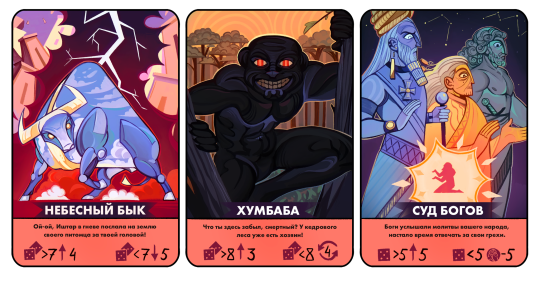
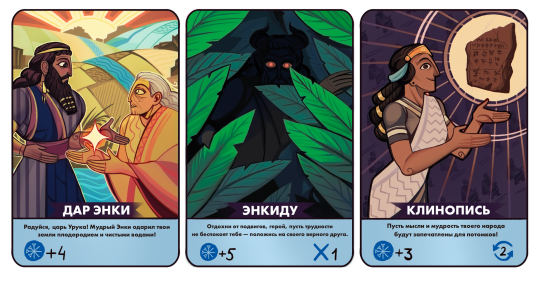
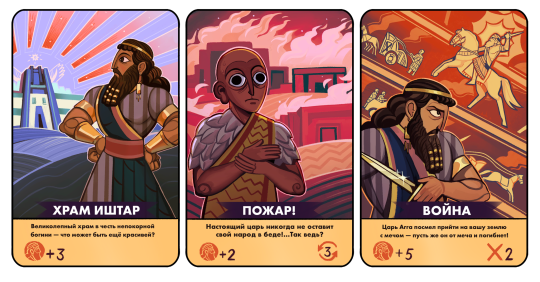
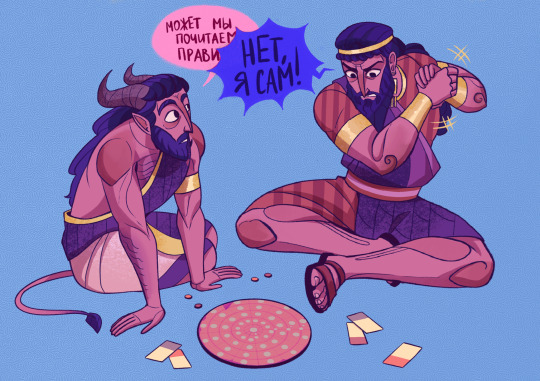
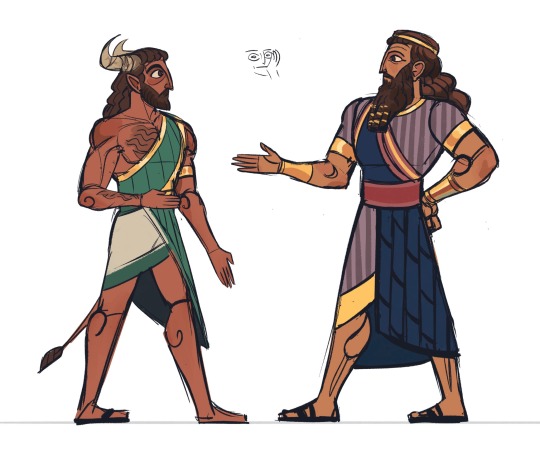
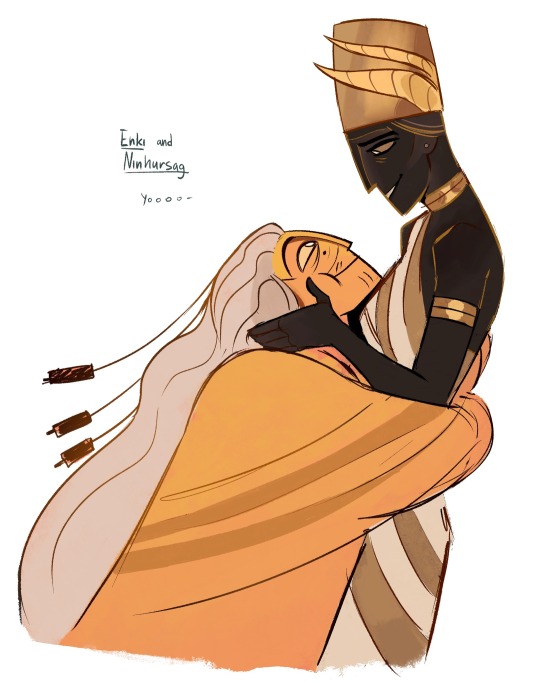
Aaand some of arts I made for a university. The whole first course we’ll be doing different projects based on already existing books or other media pieces, so I’ve chosen Epic Of Gilgamesh cause Mesopotamian mythology is cool and sexy.
The fist four pics is from the board game based on Gilgamesh’s story (1-3 is cards and the fourth pic is an illustration from the manual), the last two pics are just some goofy designs — Enkidu, Gilgamesh, Enki and Ninhursag. Sorry for Russian test, I’m just too lazy to translate.
Yeah, I drew them a little different from their original descriptions, but eh, it’s for a sake of diversity.
Oh, and I’m studying animation! I still can’t quite believe that I’m in this point of my life.
#mesopotamian mythology#sumerian mythology#ancient sumeria#Gilgamesh#Enkidu#Enki#Ninhursag#Humbaba#Heavens Bull#and others#babygworls
315 notes
·
View notes
Text
List of Mesopotamian deities✨
Mesopotamian legendary beasts ✨
☆Battle Bison beast - one of the creatures slain by Ninurta
☆The eleven mythical monsters created by Tiāmat in the Epic of Creation, Enûma Eliš:
☆Bašmu, “Venomous Snake”
☆Ušumgallu, “Great Dragon”
☆Mušmaḫḫū, “Exalted Serpent”
☆Mušḫuššu, “Furious Snake”
☆Laḫmu, the “Hairy One”
☆Ugallu, the “Big Weather-Beast”
☆Uridimmu, “Mad Lion”
☆Girtablullû, “Scorpion-Man”
☆Umū dabrūtu, “Violent Storms”
☆Kulullû, “Fish-Man”
☆Kusarikku, “Bull-Man”
Mesopotamian Spirits and demons ✨
☆Alû, demon of night
☆Asag - monstrous demon whose presence makes fish boil alive in the rivers
☆Asakku, evil demon(s)
☆The edimmu - ghosts of those who were not buried properly
☆Gallû, underworld demon
☆Hanbi or Hanpa - father of Pazuzu
☆Humbaba - guardian of the Cedar Forest
☆Lamashtu - a malevolent being who menaced women during childbirth
☆Lilû, wandering demon
☆Mukīl rēš lemutti demon of headaches
☆Pazuzu - king of the demons of the wind; he also represented the southwestern wind, the bearer of storms and drought
☆Rabisu - an evil vampiric spirit
☆Šulak the bathroom demon, “lurker” in the bathroom
☆Zu - divine storm-bird and the personification of the southern wind and the thunder clouds
Mesopotamian Demigods and Heroes ✨
☆Adapa - a hero who unknowingly refused the gift of immortality
☆The Apkallu - seven demigods created by the god Enki to give civilization to mankind ☆Gilgamesh - hero and king of Uruk; central character in the Epic of Gilgamesh
☆Enkidu - hero and companion of Gilgamesh
☆Enmerkar - the legendary builder of the city of Uruk
☆Lugalbanda - second king of Uruk, who ruled for 1,200 years
☆Utnapishtim - hero who survived a great flood and was granted immortality; character in the Epic of Gilgamesh
Mesopotamian Primordial beings✨
☆Abzu - the Ocean Below, the name for fresh water from underground aquifers; depicted as a deity only in the Babylonian creation epic Enûma Eliš
☆Anshar - god of the sky and male principle
☆Kishar - goddess of the earth and female principle
☆Kur - the first dragon, born of Abzu and Ma. Also Kur-gal, or Ki-gal the underworld
☆Lahamu - first-born daughter of Abzu and Tiamat
☆Lahmu - first-born son of Abzu and Tiamat; a protective and beneficent deity
☆Ma -primordial goddess of the earth
☆Mummu - god of crafts and technical skill
☆Tiamat - primordial goddess of the ocean
Mesopotamian Minor deities✨
This is only some of them. There are thousands.
Abu - a minor god of vegetation
Ama-arhus - Akkadian fertility goddess; later merged into Ninhursag
Amasagnul - Akkadian fertility goddess
Amurru - god of the Amorite people
An - a goddess, possibly the female principle of Anu
Arah - the goddess of fate.
Asaruludu or Namshub - a protective deity
Ashnan - goddess of grain
Aya - a mother goddess and consort of Shamash
Azimua - a minor Sumerian goddess
Bau - dog-headed patron goddess of Lagash
Belet-Seri - recorder of the dead entering the underworld
Birdu - an underworld god; consort of Manungal and later syncretized with Nergal
Bunene - divine charioteer of Shamash
Damgalnuna - mother of Marduk
Damu - god of vegetation and rebirth; possibly a local offshoot of Dumuzi
Emesh - god of vegetation, created to take responsibility on earth for woods, fields, sheep folds, and stables
Enbilulu - god of rivers, canals, irrigation and farming
Endursaga - a herald god
Enkimdu - god of farming, canals and ditches
Enmesarra - an underworld god of the law, equated with Nergal
Ennugi - attendant and throne-bearer of Enlil
Enshag - a minor deity born to relieve the illness of Enki
Enten - god of vegetation, created to take responsibility on earth for the fertility of ewes, goats, cows, donkeys, birds
Erra - Akkadian god of mayhem and pestilence
Gaga - a minor deity featured in the Enûma Eliš
Gatumdag - a fertility goddess and tutelary mother goddess of Lagash
Geshtinanna - Sumerian goddess of wine and cold seasons, sister to Dumuzid
Geshtu-E - minor god of intelligence
Gibil or Gerra - god of fire
Gugalanna - the Great Bull of Heaven, the constellation Taurus and the first husband of Ereshkigal
Gunara - a minor god of uncertain status
Hahanu - a minor god of uncertain status
Hani - an attendant of the storm god Adad
Hayasum - a minor god of uncertain status
Hegir-Nuna - a daughter of the goddess Bau
Hendursaga - god of law
Ilabrat - attendant and minister of state to Anu
Ishum - brother of Shamash and attendant of Erra
Isimud - two-faced messenger of Enki
Ištaran - god of the city of Der (Sumer)
Kabta - obscure god “Lofty one of heaven”
Kakka - attendant and minister of state to both Anu and Anshar
Kingu - consort of Tiamat; killed by Marduk, who used his blood to create mankind
Kubaba - tutelary goddess of the city of Carchemish
Kulla - god of bricks and building
Kus (god) - god of herdsmen
Lahar - god of cattle
Lugal-Irra - possibly a minor variation of Erra
Lulal - the younger son of Inanna; patron god of Bad-tibira
Mamitu - Sumerian goddess of fate
Manungal - an underworld goddess; consort of Birdu
Mandanu -god of divine judgment
Muati - obscure Sumerian god who became syncretized with Nabu
Mushdamma - god of buildings and foundations
Nammu - a creation goddess
Nanaya - goddess personifying voluptuousness and sensuality
Nazi - a minor deity born to relieve the illness of Enki
Negun - a minor goddess of uncertain status
Neti - a minor underworld god; the chief gatekeeper of the netherworld and the servant of Ereshkigal
Nibhaz - god of the Avim
Nidaba - goddess of writing, learning and the harvest
Namtar - minister of Ereshkigal
Nin-Ildu - god of carpenters
Nin-imma - goddess of the female sex organs
Ninazu - god of the underworld and healing
Nindub - god associated with the city Lagash
Ningal - goddess of reeds and consort of Nanna (Sin)
Ningikuga - goddess of reeds and marshes
Ningirama - god of magic and protector against snakes
Ningishzida - god of the vegetation and underworld
Ninkarnunna - god of barbers
Ninkasi - goddess of beer
Ninkilim - "Lord Rodent" god of vermin
Ninkurra - minor mother goddess
Ninmena - Sumerian mother goddess who became syncretized with Ninhursag
Ninsar - goddess of plants
Ninshubur - Sumerian messenger goddess and second-in-command to Inanna, later adapted by the Akkadians as the male god Papsukkal
Ninsun - "Lady Wild Cow"; mother of Gilgamesh
Ninsutu - a minor deity born to relieve the illness of Enki
Nintinugga - Babylonian goddess of healing
Nintulla - a minor deity born to relieve the illness of Enki
Nu Mus Da - patron god of the lost city of Kazallu
Nunbarsegunu - goddess of barley
Nusku - god of light and fire
Pabilsaĝ - tutelary god of the city of Isin
Pap-nigin-gara - Akkadian and Babylonian god of war, syncretized with Ninurta
Pazuzu - son of Hanbi, and king of the demons of the wind
Sarpanit - mother goddess and consort of Marduk
The Sebitti - a group of minor war gods
Shakka - patron god of herdsmen
Shala - goddess of war and grain
Shara - minor god of war and a son of Inanna
Sharra Itu - Sumerian fertility goddess
Shul-pa-e - astral and fertility god associated with the planet Jupiter
Shul-utula - personal deity to Entemena, king of the city of Eninnu
Shullat - minor god and attendant of Shamash
Shulmanu - god of the underworld, fertility and war
Shulsaga - astral goddess
Sirara - goddess of the Persian Gulf
Siris - goddess of beer
Sirsir - god of mariners and boatmen
Sirtir - goddess of sheep
Sumugan - god of the river plains
Tashmetum - consort of Nabu
Tishpak - tutelary god of the city of Eshnunna
Tutu - tutelary god of the city of Borsippa
Ua-Ildak - goddess responsible for pastures and poplar trees
Ukur - a god of the underworld
Uttu - goddess of weaving and clothing
Wer - a storm god linked to Adad
Zaqar - messenger of Sin who relays communication through dreams and nightmares
Mesopotamian Major Deities✨
Hadad (or Adad) - storm and rain god
Enlil (or Ashur) - god of air, head of the Assyrian and Sumerian pantheon
Anu (or An) - god of heaven and the sky, lord of constellations, and father of the gods
Dagon (or Dagan) - god of fertility
Enki (or Ea) - god of the Abzu, crafts, water, intelligence, mischief and creation and divine ruler of the Earth and its humans
Ereshkigal - goddess of Irkalla, the Underworld
Inanna (later known as Ishtar) - goddess of fertility, love, and war
Marduk - patron deity of Babylon who eventually became regarded as the head of the Babylonian pantheon
Nabu - god of wisdom and writing
Nanshe - goddess of prophecy, fertility and fish
Nergal - god of plague, war, and the sun in its destructive capacity; later husband of Ereshkigal
Ninhursag (or Mami, Belet-Ili, Ki, Ninmah, Nintu, or Aruru) - earth and mother goddess
Ninlil - goddess of the air; consort of Enlil
Ninurta - champion of the gods, the epitome of youthful vigor, and god of agriculture
Shamash (or Utu) - god of the sun, arbiter of justice and patron of travelers
Sin (or Nanna) - god of the moon
Tammuz (or Dumuzid) - god of food and vegetation
15 notes
·
View notes
Text
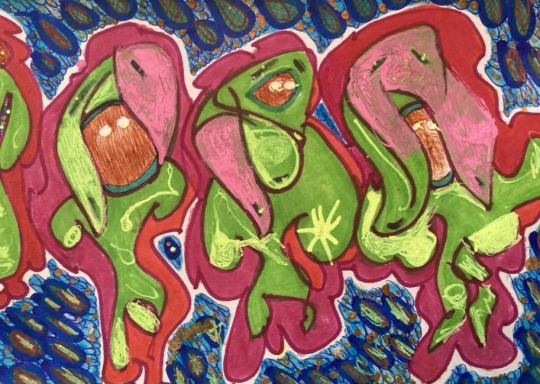
"Enlil,Enki,Ninhursag"
22cm x 28cm / 8.5" x 11"
ink, oil pastel, & acrylic on paper
©Drew Schermick 2024
$800.00 private sale price...
8 notes
·
View notes
Text
God Apsû (Abzu)
𒀊𒍪
Akkadian God in the Enūma Eliš
Mesopotamian Terminology
As a God: Apsû was the primordial freshwater sea in Babylonian mythology, one of the first two Gods of creation along with the salt sea Tiāmat.
As terminology: prior to the myth of the Enūma Eliš, Apsû (Akkadian) / Abzu (Sumerian) was known as a non-anthropomorphic cosmological location— the very source of all fresh water on Earth—home to many gods, principally Ea (Akkadian) / Enki (Sumerian). The Apsû/Abzu also referred in some cases to water than can be accessed at the surface in order to pinch off clay or to catch fish— according to Jensen (Link). The Abzu/Apsû was also the name for tanks of holy purified water.
Thus the term is multifaceted. However, the anthropomorphic God Apsû of the Enūma Eliš does not seem to have been worshipped in Mesopotamia.
—How to use the internet archive Link
🔵 Information
From Oracc [Link]
The abzu (Sumerian form) or apsû (Akkadian form) was a large underground body of water in Mesopotamian cosmic geography. It was the domain of the god Enki/Ea. The city of Babylon was said to have been built on top of the abzu, and the Sumerian myth Enki and Ninhursag describes that the first humans were created from clay taken from the top of the abzu.
From Gods Demons & Symbols of Ancient Mesopotamia by Jeremy Black & Antony Green [Internet Archive Link]
Abzu (apsû)
Although it can sometimes rain very hard in southern Mesopotamia, it was anciently believed that springs, wells, streams, rivers and lakes drew their water from and were replenished from a freshwater ocean which lay beneath the earth in the abzu (apst) or engur. (The salt sea, on the other hand, surrounded the earth.) The abzu was the particular realm and home of the wise god Enki (Ea), his wife Damgalnuna (Damkina) and his mother Nammu, and was also inhabited by a number of creatures subordinate to him (see Enki's creatures).
Enki was thought to have occupied the abzu since before the creation of mankind.
According to the Babylonian Epic of Creation, Apsû was the name of a primal creature, the lover of Tiāmat, and when Ea killed Apsû, he set up his home on the dead creature's body, whose name was henceforth transferred to Ea's residence. Marduk, as Ea's son, was called 'firstborn son of the aps‹'. Enki's temple at Eridu was known as E-abzu, 'Abzu temple'.
The underworld was located even further down, beneath the abzu. Since in some traditions it was necessary to cross a river (the Hubur) to reach the underworld, the river may sometimes have been identified with the abzu (see river of the underworld).
The term abzu/apsû was also used to designate a tank for holy water in a temple courtyard.
From A Dictionary of Ancient Near Eastern Mythology by Gwendolyn Leick [Internet Archive Link]
Apsu
from Sumerian Abzu, which denotes the subterranean 'sweet water ocean or groundwater, also generally the marshland of southern Mesopotamia.
In this area where rainfall is rare and where the semi-floating reed-islands support a great variety of wild life, the fertile marshes were regarded as the source of abundance. In mythological terms the Apsu extended underneath the surface of the earth, into a watery depth.
Several literary texts express the creative potential of the Apsu's muddy moisture. In the Sumerian myth Enki and Ninmah it is the place where Nammu forms the first human being. The god Kullu was also made there, according to the enuma Am ritual. Furthermore, an anthropomorphic Apsu is called the begetter of the great gods' in the cosmogonic beginning of the Enuma elis (1, 59-78). In this composition the Apsu is inert and sleepy but finds his peace disturbed by the restless ways and clamour of the younger gods, the offspring of his union with another watery body, Tiamat. He decides to destroy them. The gods choose Ea as their champion and he puts a spell on Apsu, casting him into a deep sleep and 'killing him'. This death, however, does not annihilate the essence of the Apsu, it just renders him without any will of his own. Thereby the Apsu is contained underground and becomes the dwelling of Ea Enku, the 'Lord of the Apsu' One of the oldest sanctuaries in Mesopotamia was at the southern city of Eridu, which was apparently situated on a hillock surrounded by a lagoon. In historical times, the temple was known as E-abzu, 'the House of the Apsu', and dedicated to Enki. Other cult-centres seem to have had natural or artificial ponds or basins which represented the Apsu.
From A Handbook of Gods and Goddesses of the Ancient Near East by Douglas R Frayne and Johanna H Stuckey [Google Book Link]
Apsû(m) (Akk.), Abzu (Sum.)
Primeval deity of sweet (fresh) subterranean waters, which were the source of springs, lakes, rivers, and well water.
His consort was Ti'amat. The Enūma Eliš told how, in the beginning, the god Apsû(m), sweet waters, mingled with the goddess Ti'amat, salt waters. Another entity, Mummu, Apsû's minister or vizier, might also have been with them. The joining of the primordial pair begat a line of deities starting with Lahmu(m) and Lahamu(m) and fol-lowed, in sequence, by An-sar and Ki-Sar, Anu(m), Ea, and, finally, Marduk.
The younger gods were so rowdy and raucous that their parents could not get any sleep. Finally, Apsû(m) persuaded a reluctant Ti'amat that they should rid themselves of their noisy children. When the younger gods got wind of the plan, they quieted down until wise Ea thought of a solution. He put a magical sleeping spell on Apsû(m) and then, while Apsû(m) slept, Ea killed him. On Apsû(m)'s dead body Ea built his house at Eridu and called it
"Apsu(m)," the name of Ea's Eridu temple (E-Apsû) from then on. Marduk, Ea's son, was born in the Apsû(m). An Abzu/ Apsû(m) tank filled with holy water stood in most temple court-yards.
From Bad King, False King, True King: Apsû and His Heirs by Karen Sonik [JSTOR Link]
The problem of accurately pinpointing Apsû’s role and identity within Enuma elis, whether as monster or personified or deified subterranean waters, springs both from the shifting nature of his depiction in the narrative and from the writing of his name therein, which never includes the divine determinative that marks the gods proper within the text. Portrayed as an elemental entity at the opening of the epic as he mingles his waters with those of Tiamat, Apsû does not remain such for long. Once the first gods are generated from his intercourse with Tiamat, beginning the process of differentiation, Apsû himself seems to morph into a sort of proto-god, still not endowed with the dingir-determinative but newly provided with anthropomorphic features and with insignia reflecting his new rank and status: He is given both a voice and a mouth with which to speak (Ee I 35–36); a more or less anthropomorphic physical form (I 53–54), clothing or insignia including at least an agû, crown; and possibly also a riksu, sash or tie (I 67); melammu (I 68); and a rudimentary household of the type standard for the great gods, though here simply comprising his vizier or counselor Mummu (I 30–31). On the subject of Aprû’s state of dress, it is worth reiterating the association of clothing with life in Mesopotamian literature, specifically with civilized life. Thus, in well-known episodes from the SB Epic of Gilgames, Enkidu dons clothing as the second step in his transformation from wild proto-man to civilized man of the city (Gilg. SB II 34–35), while Gilgames, who dresses in lion skins during his wanderings in the wild, again dons his clean royal finery before returning to human civilization (XI 250–70). In the case of Apsû, his assumption of the agû may similarly signify his transformation into a more civilized and active entity, the direct result of his contribution to the differentiation and organization of the world through the generation of the gods.
From The Tablet of Destinies and the Transmission of Power in Enūma Eliš by Karen Sonik [PDF Link]
The opening lines of the epic describe the mingling of two primordial and el- emental entities, Apsû and Tiāmat, who generate the first gods and who seem to evolve thereby into active proto-deities, complete with at least semi-anthropomor- phic forms and divine powers and attributes. As the parents of all the gods, Apsû and Tiāmat may also be read as the first rulers of the text, legitimately endowed with divine authority over the gods. Apsû, as befits a king, stands at the head of a line of legitimate heirs, among them Lahmu and Lahamu, Anšar and Kišar, Anu, Ea, and ultimately Marduk, who comprise the great gods. He is also the apparent progenitor of a mass of unnamed and undifferentiated descendents, who comprise the lesser gods. Legitimate power, so far, is relatively concentrated: it is located in the hands of Apsû and Tiāmat and their rightful heirs. This situation, however, does not last.
[Footnote 6] Apsû and Tiāmat are not gods proper as has sometimes been suggested, ibid. Their names, unlike those of the rest of the gods in Enūma eliš, are never written with the divine determinative (Anšar alone is excepted, as his name begins with the dingir sign). Following the generation of the first gods from the mingling of their waters, however, Apsû and Tiāmat do seem to evolve into proto-deities, possibly as a result of the civilizing qualities of sexual intercourse [...]
[Footnote 7] Whether he is to be understood as the first king or ruler, Apsû is certainly the first major male authority figure to appear in Enūma eliš by virtue of his position as the father of all the gods. (Page 388)
🔵 Myth: Enūma Eliš
The myth he appears in. It was a very political myth used to justify Marduk as chief deity and therefore the government.
Read it:
LW King Translation from 1902 — Link
Translation on Electronic Tools and Ancient Near East Archives (ETANA) — Link
Compiled translation primarily based on E.A Speiser — Link
E.A Speiser's translation is available in The Ancient Near East an Anthology of Texts and Pictures by James Pritchard page 28. — Link
🔵 Iconography
None that we know of, but here is one of the ritual pools:

🔵 Ask answered about modern worship of Apsû as an anthropomorphic deity despite him lacking historical worship. — Link
#polytheism#paganism#landof2rivers#abzu#apsu#mesopotamia#babylonian#sumerian#levpag#deity resource#queue
9 notes
·
View notes
Text

Angelique Benicio, Ninhursag, 2024, oil on wood, 8 × 10 inches.
8 notes
·
View notes
Text
Info: Kirk is raped in front of Spock and Uhura. They're horrified, he's angry and offended. Finished. (thread)
Note: this is not the fic from the prompt which is titled interrogation techniques by vainficgirl HOWEVER I am positive the user ninhursag on ao3 is the same person, and while they don't have this exact fic up on ao3, they have a very similar one imo so I have linked it here.
Fill: 1/1
Author: ninhursag (vainficgirl)
Archive Link
#I think the vyvanse is hitting hard I'm so fucking focused right now#spock/kirk/uhura#ninhursag#vainficgirl#archiving#star trek#kink meme#st xi kink
1 note
·
View note